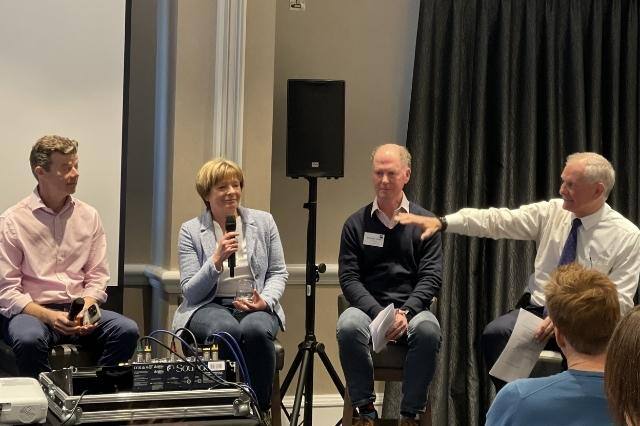
Top nine lead generation tips for small businesses
by Jonathan Silverman
Listen to Audio Version:
It’s tough running a small business. Lead generation is time-consuming, expensive and difficult. And, if it’s just you that needs to do the sales role in your business alongside managing other functions, it’s doubly difficult.
There are lots of articles proffering advice on what you need to do. Do this. Do that. Do something else. The problem is that there’s often only one or very few directors or employees in the business and they’re running the business on a day to day basis. If you’ve read the book The E-myth, you'll know what I mean and the problems that situation causes. .
Are you a high-performing sales superhero?
If you’re great at doing stuff but not so good at being creative and driving your business forward, you may have a problem. Not everyone is a high-performing salesperson with the gift of the gab. If that’s not you, what do you do? Whilst there are plenty of options outside of face to face and phone selling, where do you put your time, energy and hard-earned money?
Clearly, we are all at different stages of our business journey. I’ve run my business for 20 years and I had a strong corporate career prior to that. I also live and breathe sales and marketing so it could be argued that it’s easier for me. Yet, we operate in a very crowded marketplace. Hence, the cost of acquisition can be high and our charges are driven down, especially in this climate.
Specialisation versus generalisation
With the above in mind, you need to work out, first and foremost, where your new business will come from. That means you need to focus on a distinct audience or small set of audiences. Did you leave corporate life with a little black book of contacts, and even a few clients? If so, start there. It’s perhaps obvious, but you should try to leverage your contacts.In an ideal world, you don’t want all your eggs in one basket but, not least in the current global climate, business is business. Contacts and referrals will probably be the lowest cost of acquisition and the highest probability of conversion. That principle doesn’t go away when your business is more developed. Make sure you work hard to build case studies, gather testimonials and gain referrals.
If you’re a specialist in a certain sector, work out where your audience goes for information, knowledge, and inspiration. Can you contribute to the discussion? Try to be present and visible.
Articles such as these often talk about the value of networking. Networking can be important and a great source of support when you're running a small enterprise. However, networking may well be good for certain types of businesses, but take care not to overdo it. There are so many networking options and there’s a risk that it will not only eat up your money, it will also do the same for your time. And, don’t forget, most networking attendees are, sadly, there to sell and not to buy. So, choose wisely.
Be selective. Identify online and offline events where your target market is present. Join groups (LinkedIn, industry, Facebook etc) that fit your sector targets and/or the type of decision-maker you want to reach. There’s no point being visible to facilities managers if the people that buy your products and services are Finance Directors, unless the Facilities manager specifies and is an influencer and the FD just signs the cheque.
Ultimately, your most crucial decision is to tightly define your target audience. It drives most of the other decisions you need to take in terms of growing your business. Build your network around that and you won’t go far wrong. It will also save you money and time.
Multi-channel targeting makes sense
Once you're clear on your audience and where they congregate, you can focus on the best channel to reach them. Clearly, if you have a business audience, LinkedIn may well be your channel of choice. But, you can’t ignore Facebook, YouTube , Twitter and Instagram. But, once again, it depends on your target market. If you run a small business with small resources, you can't can’t be everything to everyone and you can’t be everywhere. So, try to master fewer more relevant channels and you’ll see greater return on investment.
Marketing convention tells us that you need what’s called ‘multiple touch points’ for a client to buy from you. In other words, they need to see you in multiple places before they will engage with you. Whilst that may be the view of marketing purists, and there is some truth to this, it doesn’t help us mere mortals with a tight budget. Few small businesses can be everywhere and do everything. You have to pick your battles so to speak.
You’ve got to look the part
Credibility is important. In today’s business world, you have very little time to make an impression. If you’re selling to plumbers, act like a plumber. But, if your business is in the City of London, you need an altogether different image. Whilst we can’t all necessarily afford a super-slick and expensive website and stunning brochures and the like, it pays to try to deliver something that is easy to use and that appeals to your target audience. And, consistency across all your communication materials helps. If the message and look of your website mirrors what you say in your marketing materials and on social channels, it makes a difference.
Today, with resources such as Fiverr, Freelancer and so on, you can get an image that looks good for relatively little. That includes a good logo, a nice PDF brochure and a website that showcases your services. But, more than the look, you need to place emphasis on the message. If you’re not a budding Shakespeare, once again, find someone that can write you some good, concise words that create the right impression. There are plenty of freelance copywriters you can use on the sites above.
Work out your cost per acquisition
We all talk about ROI. But, do you know what a lead should cost? Inevitably, it will vary depending on a number of factors. You can use online tools to work out what your cost per lead would be for Pay per Click ads on Google, Facebook and so on. You can pretty much do the same with most social channels since they recommend a level of spend and tell you what competitors are bidding to reach X number of viewers or a certain number of eyeballs (impressions).
This form of advertising isn’t for everyone and it can work out quite expensive for competitive terms. It pays, therefore, to do your research and, perhaps, to speak to an expert in the field who can save you money and maximise effectiveness by testing and measuring.
The same goes for other routes to market. Some forms of marketing suit certain methods of marketing. If you know your cost of sale e.g. you know your conversion rates from lead to sale, you’ll be in a much better position to determine what might work. If the purchase of your products and services is a high-end considered decision or has implications for Capital Expenditure, you may need to invest more to secure a lead and convert the sale. That’s where solutions such as telemarketing may come in. You will certainly need to build credibility and PR is a good way to do that, especially if you have a narrow industry bias where you can, once again, focus your energy.
If LinkedIn is where your customers are, there are automation tools such as Dux-Soup that help you increase your reach and frequency of messaging without doing it yourself. You can choose sponsored ads and purchase emails. There are any number of solutions you can select on the various platforms. But, once again, focus is key or you’ll spread yourself and your budget too thinly and fail to deliver any positive return on investment.
In an article such as this it’s almost impossible to even scratch the surface of the range of marketing channels and options. We haven’t spoken about straight advertising, email marketing, sponsoring events online or offline if we’re still allowed to go. You could run webinars. This is a particularly well-used technique used by technology vendors. Nowadays, with Event-Brite, Paypal and software such as Microsoft Teams, Zoom, Google Hangouts and the like, it’s relatively easy to set up an online session. Whichever option you choose, let your audience be your guide and try to work out the likely ROI of your activity.
Content is king
I’ll be honest. I love content. If I’m being even more truthful, I don’t read much content. I just like producing it. And, I like doing that for two reasons. It brings me leads and it is my lowest cost of marketing. Even though I run a lead generation business where one of our core services is telemarketing, I’d probably recommend content development over all other forms of marketing. However, it is far from a quick fix so don’t let anyone tell you otherwise.
This article is a good example of content. I enjoy writing. I am also not averse to a video or three. Even with a face for radio, I am comfortable in front of a camera. My videos aren’t all perfect but they do a job. I have produced many blogs, videos, infographics and podcasts over the years. There are over 300 knowledge-based pieces of content about lead generation on our website in the knowledge bank. As a consequence, Google likes my business and sends me leads, for example, when people type in B2B lead generation. This is ultimately what I blog about and it’s the subject of the bulk of my content.
I use tools such as Hootsuite to post onto the various social platforms. It saves me a lot of time. However, I also personally post several times each week on LinkedIn (where my audience lives!). This is what’s called ‘native’. In other words, you post directly on LinkedIn, Facebook, Instagram or YouTube etc. If you do that, the platform favours your content since it wants viewers of that content to stay within the platform. If you don’t have time, perhaps find a Virtual Assistant, family friend, or a student who can do stuff for you in their spare time.
Share and distribute content
Without wishing to become a content bore, I can’t emphasise enough its value. It enhances your credibility and visibility. Over time, it will improve search engine ranking and it helps differentiate you from competitors, especially if they aren’t producing anything. The key is to ensure that your content is clearly produced with a specific audience in mind and reaches the maximum number of the right target prospects. Therefore, you need shareable content. A good way of doing this is to produce top tips. We do this quite a bit and it works.
I’ve provided some examples of content below. One of our videos on top telemarketing tips has had over 100k views on YouTube and often hits top ranking on Google. Type that phrase inio Google and see.
- Ten Tips for Better Telemarketer Results
- 5 Things to Power your LinkedIn Lead Generation
- 50 Behaviours telemarketers must adopt to Power Lead Generation Infographic
For not very much money, you can use outsourcing services such as FatJoe for blogs and articles. You can find cartoon video producers on Fiverr. You can also have a cool infographic designed for a relatively small sum of money. So, it doesn’t all have to fall at your door when you are either busy or it isn’t your bag.
ABM - the latest cool thing in sales and marketing
Account Based Marketing is hot. Everyone is speaking about it in the marketing world. So, I thought I’d include a few words on the topic since you may be aware of it. Boiled down to plain language, it’s about focusing on a niche and then micro-targeting those organisations you’d like to work with in that niche. That means using some of the methods above and others, to reach out to a cross-section of management within those organisations.
It’s then about personalisation. Ultimately, it can make sense for small businesses that don’t want to spread themselves too thinly. It concentrates resources on a set of target accounts within a market where you tailor campaigns to engage each account based on a specific set of needs. Of course, you need to identify those needs and get them right but it, at least, focuses your attention and enables you to avoid too much wastage from going far and wide with your sales and marketing efforts.
The end analysis
Sadly, there is no silver bullet. This is a long article but it could be so much longer. There's always going to be a bit of trial and error, test and measure about sales and marketing. If you’re lucky enough to be in a lucrative niche, that’s great. But, Pret a Manger had a strategy of locating their sites close to town centre offices. That approach has come to haunt them recently where they’re paying high rents for almost no footfall. So, you need to consider the risk of niching too tightly against the benefits of doing so.
Seek support if you aren’t able to do it all yourself. That may be by bringing in an in-house resource if you can afford it. It could be a temporary resource from a family member or friend who has knowledge of something you’re trying to do. It could be using sites such as Freelancer where you can leverage the gig economy to get marketing solutions relatively inexpensively.
You could use a Virtual Assistant. I certainly recommend automation where possible for sharing content and mastering LinkedIn.
Above all else, though, it’s about focus. You won’t hit a target if you can’t see it. If you can identify your target market and pull together a robust plan to reach out to the decision-makers that purchase your services, you won’t go far wrong.
Article Copyright - Jonathan Silverman, Managing Director, GSA Business Development Ltd, Jonathan writes regularly and produces videos on topics such as lead generation, marketing and telemarketing.
Related articles

The 7 Best Tools for Business Intelligence 2024
This is a comprehensive guide to the best tools for business analysis. Learn about which tools are best for analysing your business with this in-depth post

How to Train Employees to Spot Social Engineering Attacks
Stay protected from social engineering attacks with our complete guide. Get tactics, training, security policies, and technology to keep your business safe

Business Growth Networks: Building Connections in 2025
Discover how business growth networks in 2025 help UK leaders build valuable connections, find new opportunities, and accelerate sustainable growth.





